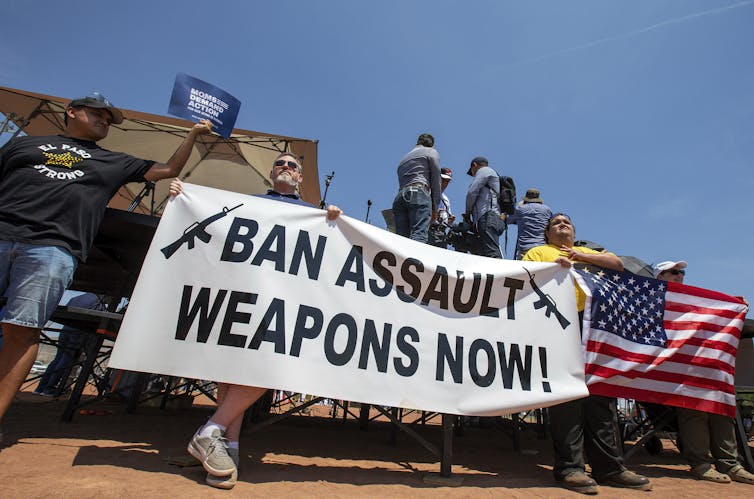
R. Blake Brown, Saint Mary’s University
The recent mass shooting that killed 19 children and two teachers at Robb Elementary School in Uvalde, Texas, has sparked another round of the gun control debate.
The shooter reportedly used an AR-15-type rifle, bought just after he turned 18. The AR-15 has been controversial in the United States and Canada for decades, and, in 2020, Prime Minister Justin Trudeau’s government prohibited the weapon.
Assault-style rifle characteristics
Several characteristics of the AR-15 make it dangerous in the wrong hands. It is a semi-automatic firearm, meaning it can be fired repeatedly — once for each pull of the trigger. And it can be reloaded in seconds by removing its cartridge magazine and replacing it with a loaded one.
A less frequently commented upon feature of the AR-15 is that it usually fires a version of the ammunition used by many NATO soldiers to kill enemy troops. As shown in Texas, and many other mass shootings, that ammunition is also extremely effective at harming civilians. The Texas killer purchased 1,600 rounds of the ammunition.
Journalists have debated whether to detail the bodily harms experienced by mass shooting victims. Some believe that failing to describe the physical effects of rifle bullets sanitizes mass shooting events, and suggest that greater public knowledge about victims’ injuries might affect the gun control debate.

Dangerous high-velocity ammunition
Ammunition is often defined by its calibre — that is, by the diameter of the projectile fired. Firearm calibres are designated in millimetres or inches. The .223-inch calibre ammunition (or 5.56mm) used in most AR-15s is smaller than the rounds employed in many rifles traditionally used for hunting game, like the .308.
However, the small size of the .223 ammunition doesn’t mean it’s safe. It was developed in response to the American military’s desire in the post-Second World War period to create a small-calibre, high-velocity weapon. The .223 round was light, meaning that soldiers could easily carry many rounds for their rifles.
The firearms industry mass-marketed semi-automatic rifles like the AR-15, and such weapons became increasingly popular by the late 20th century. Unfortunately, rifles firing .223 ammunition also frequently became a favourite weapon of mass shooters.
Defenders of the AR-15 sometimes downplay the dangers of such guns. For example, in 2020, the vice-president of a Canadian gun lobby group, the Canadian Coalition for Firearm Rights, tweeted a picture of her AR-15 and called it a “a low-powered sport rifle.”
However, doctors who have treated the victims of mass casualty events have described the serious injuries inflicted by ammunition fired from assault-style rifles.
Graphic detail of injuries and damage
While gun advocates generally avoid discussing the harm that assault-style rifles can cause, there are exceptions.
Before he became
.Giltaca introduced his 2013 video, focused on wound characteristics, by stating that there was “some misconception about the .223 cartridge” and that he wanted to show “how dangerous that cartridge still is, even though, yes, it’s a small bullet.” He pointed out that unlike rounds fired from handguns, the “.223 travels really, really fast, and that creates some problems should you get hit with it.”
Giltaca detailed the various “problems” a human body experienced if shot with a .223 rifle bullet.
For example, he said the bullet produces a “little shockwave,” which leads to a “temporary stretch cavity.” If the bullet strikes a thigh, for example, “it’s going to suck a bunch of air in there.” This leads to “massive tissue disruption and tissue death” because “your skin has been pulled apart and it tears, and it collapses back together again.”
Giltaca concluded by offering his “bottom line.” Rifles firing ammunition like .223 rounds “are really, really dangerous,” for if “you get hit with a rifle round, you’re not coming back.”
Americans have been reminded of this over and over again in mass shootings committed with assault-style rifles. And, unfortunately, Canadians have also learned about the dangers of such guns.
The rifle used in the Montréal massacre in 1989, the now prohibited Mini-14, fired .223 ammunition. Fourteen young women died as a result.![]()
R. Blake Brown, Professor, History, Saint Mary’s University
This article is republished from The Conversation under a Creative Commons license. Read the original article.


